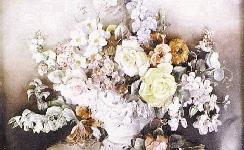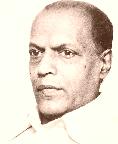



| HOME PAGE | FRONT PAGE | EDITORIAL/OPINION | NEWS / COMMENT | BUSINESS
![]()
It is mentally soothing and in a way I feel as if I am somewhat addicted to it says Ranee Jayasuriya
 "While
on a holiday in England a friend told me about a course on the art of ‘decoupage’,"
said Ranee Jayasuriya who started with the encouragement of her friends
and is at present practising this technique. Decouper in French means to
cut. The art form in itself is done by cutting out several figures of the
same picture. It is a technique practised by the Victorians that later
became popular in Venice and then in France.
"While
on a holiday in England a friend told me about a course on the art of ‘decoupage’,"
said Ranee Jayasuriya who started with the encouragement of her friends
and is at present practising this technique. Decouper in French means to
cut. The art form in itself is done by cutting out several figures of the
same picture. It is a technique practised by the Victorians that later
became popular in Venice and then in France.
Ms. Jayasuriya has been practising decoupage for over an year and says that there is a big demand and appreciation of the art in England where she sold some of her creations.
"I followed a six months course which I was able to complete in one month. Since then it has been a hobby," she said. It is done by cutting up three or four copies of a chosen print and then pasting them on top of each other in such a way as to give a three dimensional look.

 It
is similar to a framed photo, but in decoupage unlike in photographs it
is framed in a box style in order to accommodate the three dimensional
effect.
It
is similar to a framed photo, but in decoupage unlike in photographs it
is framed in a box style in order to accommodate the three dimensional
effect.
Decoupage is time consuming and can also test one’s patience as well. One decoupage takes more than one day since one needs to cut and paste several copies leaving room for each copy to dry on the other. "Everything should be cut up meticulously," Mrs. Jayasuriya. Much of her work involves minute details that need not only patience but concentration.
In making these decoupage creations she makes use of everything from wrapping paper to expensive glossy prints. Starting with available raw material, most of her creations are of gods and goddesses. Apart from such figures she has a wide collection of nursery rhyme pictures, pictures of flowers and fruits, animals, etc. "It is a rewarding and relaxing hobby. It is mentally soothing and in a way I feel as if I am somewhat addicted to it" she said. Her main intention is to collect as many works as she can for an exhibition which she intends to hold.
Ms. Jayasuriya hopes to train others in decoupage shortly. It was colour, colour
 The
fourth death anniversary of Donald Ramanayake, one of Sri Lanka’s most
gifted landscape artists, fell on May 2, and to commemorate this, his wife,
Leela, and the Society of Arts organised an exhibition of his work. That
was held at the Art Gallery from May 2 to 4.
The
fourth death anniversary of Donald Ramanayake, one of Sri Lanka’s most
gifted landscape artists, fell on May 2, and to commemorate this, his wife,
Leela, and the Society of Arts organised an exhibition of his work. That
was held at the Art Gallery from May 2 to 4.
From Leela, I gathered some information about Donald’s life. He was born on November 18, 1920, and his father was a planter. His mother, the daughter of a Mudaliyar. His early life was a difficult one, as he and his mother lived with some relatives of hers, not with his father.
Donald had confided to Leela that he used to spend hours in his room, alone, studying himself in a mirror and attempting to draw self portraits-a very lonely boy. His early education was at Cathedral College, Kotahena and later on he was sent to Trinity College, Kandy.
Taking a box of water colours with him, Donald used to hire a cycle for 50 cents a day, and ride to scenic spots to paint, usually choosing secluded places screened by trees. Once a group of boys surrounded and teased him, calling him a ‘’mad fellow’’. This experience made him shun company all the more.
Donald used pastels, charcoal, water colours and oils, in which he excelled. Leela owns some exquisite water colour paintings, which are, sad to say, deteriorating, due to not being framed. Donald was impressed by the work of David Paynter, and took lessons from Mudaliyar Amarasekera, but his ‘guru’, whom he always said he owed a lot to, was the Russian artist, Sofronoff.
He greatly influenced Donald, improved his style and technique, and taught him composition, blending of colours, rhythm etc. All of these combined to make Donald one of our foremost landscape painters. His love of colour dominated his work-even if he saw a very drab and bare landscape, one tree or shrub in a pleasing colour was enough to inspire him, and he would produce a beautiful work of art.
Leela told me that even if very rich food was not prepared, a little bit of colour and arrangement was very much appreciated by Donald.
Leela and Donald met at an exhibition organised by the Arts Society in 1962. She had gone there with a friend, and was looking at the exhibits when a stranger walked up to her, asked her if she liked to paint, and which artist’s work she liked. She said, ‘Donald Ramanayake’s work’ to which he said nothing. When she was leaving, he handed her his card, and she says she ‘’saw stars’’ to find that he was Donald Rama-nayake himself!
That was the beginning of a romance, and they married in 1963. At that time, Donald was a lonely widower having lost his first wife, and lived alone with a helper. When he painted, Leela would watch closely, question him about the colours and brush strokes and she learned much from him.
He achieved state and public recognition during the SLFP regime, and visited eight countries on an International Visitors programme. In the time of the UNP he visited two other countries.
Donald had no political affiliations. They lived in a rented house in Kalubowila for 30 years, and when the owner wanted it back, Donald wrote to President Premadasa, who without any delay, gave him a flat at Maligawatte, as a gift from the state.
Leela told me she has about 200 paintings by Donald, and would like to have regular exhibitions. Maybe the Arts Council (in which he was very active in his lifetime) could help to start a scholarship or award to perpetuate Donald’s memory.
Donald was a keen and generous teacher. He shared all his knowledge freely with his students, and never kept back any ‘’secrets’’-he wanted all of us to be good artists. I had the privilege of having lessons in painting in oils, from him in the late 1960s, with a group of students from Talawakelle district.
Almost 25 years later, when painting had taken a back seat in my life and priorities, I met him at one of his exhibitions, and he started coming to our home, to paint scenes of Bolgoda Lake. I own some beautiful paintings he did there, which I will always treasure.
He always remained a simple man, his only desire being to paint all the beauty he saw around him in Sri Lanka. His works, found in many homes all over Lanka, abroad and in public places, the paintings on permanent exhibition in the Art Gallery, and his influence on landscape painting in Sri Lanka will give him his rightful place in Art, in Sri Lanka.
Return to the Plus contents page
![]()
Please send your comments and suggestions on this web site to
info@suntimes.is.lk or to
webmaster@infolabs.is.lk